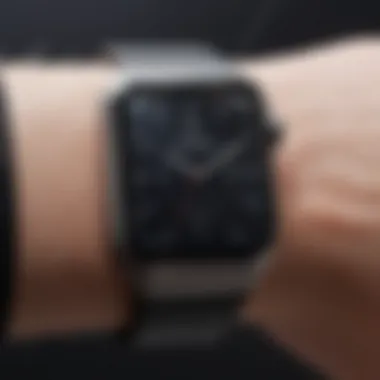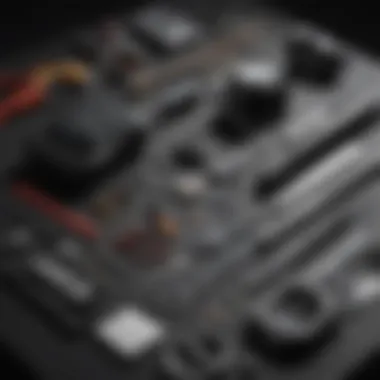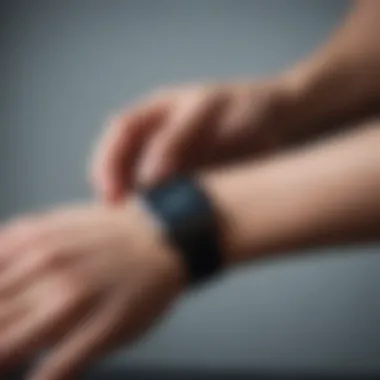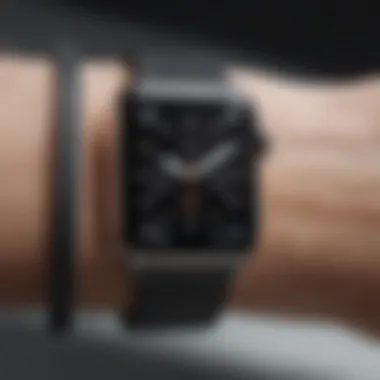The Ultimate Guide to iWatch Scratch Repair Techniques


Intro
In the age of advanced technology, the iWatch stands out as a prominent device for health tracking and connectivity. However, as users engage with their iWatches in everyday situations, scratches can harm both functionality and aesthetics. Understanding how these scratches occur, along with available repair options, becomes essential for maintainig the quality of the device. This guide aims to provide a comprehensive overview of all aspects related to iWatch scratch repair, catering to both tech enthusiasts and Apple users.
This overview includes the causes of scratches, do-it-yourself repair techniques, as well as professional services available if needed. Each section will present the advantages and disadvantages of the methods discussed, equipping readers with critical insights for their situations. By doing so, Apple users can make more informed decisions to prolong the life of their devices.
Preamble to iWatch Scratches
Scratches on your iWatch can be more than just an aesthetic concern. They can diminish the device's resale value and, in some cases, impact functionality. Understanding the nuances of iWatch scratches requires awareness of their causes, methods of repair, and how to maintain the device effectively. In this section, we will delve into the importance of recognizing these scratches and the broader implications they have for users.
Understanding the Problem
The core problem with scratches on iWatches revolves around their frequent exposure to various abrasive surfaces. Given their portable nature, iWatches often encounter harsh conditions. They can be scraped against furniture, dirty surfaces, or even during contact with other items in a bag or pocket. Each encounter contributes to the overall wear and tear that the device suffers.
The materials used to construct iWatches, though high-quality, are not immune to damage. The screen, for example, is made from Ion-X glass or sapphire crystal, depending on the model. While these materials provide reasonable resistance to scratches, they can still be vulnerable when put under stress.
Recognizing the frequent exposure your iWatch endures is crucial in understanding why it is prone to scratches. This awareness sets the stage for implementing preventative measures and understanding repair methods.
The Importance of Maintaining Your iWatch
Maintaining your iWatch is not simply about keeping it looking new; it's about ensuring its longevity and functionality. A well-maintained iWatch can serve not only as a timepiece but as a health tracker and communication device, providing numerous functionalities seamlessly.
Any scratches or damages can hinder the user experience in several ways:
- Visual Aesthetics: A scratched screen can detract from the overall look of the device, making it less appealing.
- Visibility Issues: Scratches can obstruct the display, making it harder to read notifications or messages.
- Potential for Further Damage: A compromised screen may lead to deeper issues, such as cracks or internal component damage.
Investing time in proper maintenance will not only extend the life of your iWatch but also enhance the overall user experience. Numerous methods can improve the longevity of your device, which we will explore in the sections to follow.
"A stitch in time saves nine" essentially applies to technology. Regular maintenance can save you from extensive repairs later.
Common Causes of iWatch Scratches
Understanding the common causes of iWatch scratches is essential for every user who wants to maintain their device's appearance and functionality. Knowledge about these causes helps in both preventing damage and addressing existing issues efficiently. It is particularly relevant for tech enthusiasts and Apple product users who invest in premium devices. Moreover, awareness of how scratches occur informs the choice of protective measures and repair solutions.
Daily Wear and Tear
The daily wear and tear is often the most significant contributor to scratches on an iWatch. This refers to routine activities such as checking messages, exercising, or simply wearing the watch throughout the day. Each motion invites the possibility of friction against other surfaces, particularly when engaging in physical activities. The bracelet or band can also rub against the casing or screen, gradually introducing scratches.
Over time, this consistent contact with different materials can lead to noticeable wear. Users should consider how they wear their device and opt for bands made from softer materials that minimize abrasion. Regular cleaning can also reduce the accumulation of dirt, which may contribute to the severity of scratches.
Environmental Factors
Environmental factors play a pivotal role in the scratching of the iWatch. There are multiple outside influences, such as dust, sand, and other particulate matter, that can come into contact with the watch. For instance, if you are near a construction site or at a beach, tiny particles can scratch the surface of the watch if they rub against it. Additionally, exposure to moisture or extreme temperatures can affect the iWatch's durability.
A user should assess their surroundings and take precautions when necessary. For example, wearing a protective case can shield the watch from environmental hazards while going on outdoor activities. Understanding these factors is crucial for extending the life of the device and maintaining its aesthetic appeal.
Accidental Impacts


Accidental impacts are another common cause of scratches on iWatches. This can occur during casual use, such as bumping into furniture, dropping the watch, or simply knocking it against hard surfaces. Such incidents can leave scratches that vary in depth and severity.
Users can mitigate this risk by practicing attention to their environment while wearing the watch. Additionally, some individuals may benefit from using a screen protector to provide an extra level of defense against unintentional impacts. In this context, awareness and precaution are key to preventing damage and maintaining the watch's sleek look.
"Awareness of the common causes of iWatch scratches empowers users to make informed decisions for protection and repair."
By recognizing daily wear and tear, environmental factors, and accidental impacts as primary sources of scratches, users can engage in informed preventive measures, ensuring their iWatch remains in optimal condition.
Assessing the Damage
Assessing the damage on your iWatch is a critical step in the repair process. Understanding the nature and extent of scratches will guide you in deciding whether to pursue a DIY repair method or seek professional help. A careful evaluation ensures that you do not overlook other potential issues and can prevent exacerbating the damage further. This section focuses on two essential components: visual inspection techniques and evaluating scratch depth, providing important insights for iWatch owners.
Visual Inspection Techniques
Visual inspection is the first step in assessing the damage on your iWatch. To perform a thorough visual check, follow these guidelines:
- Lighting: Ensure you examine the watch in well-lit conditions. Natural light is preferable.
- Angle of Viewing: Tilt the iWatch at various angles to reveal the true nature of scratches. Some scratches can be hard to see directly from one angle.
- Clean Surface: Before inspection, clean the screen gently. This removes smudges and dust, making scratches more visible.
Start by looking closely at the screen and the watch body. Look for any signs of scratching, dull areas, or chips. This process may help differentiate between superficial scratches and deeper damage that might require immediate attention.
Evaluating Scratch Depth
Evaluating scratch depth is crucial in determining the appropriate course of action. There are several methods to gauge how deep a scratch is:
- Feel Test: Running your finger across the scratch can help gauge its depth. If you can feel the scratch and it interrupts the smooth surface, it may be a deeper issue.
- Light Reflection: Observe how light interacts with the scratch. Deeper scratches may create shadows or distort reflections.
- Comparison with Common Objects: Using a ruler or a similarly smooth object can provide a frame of reference to gauge scratch length and depth.
In general, scratches that are visible and can be felt often extend beyond the outer coating. If damage only penetrates the surface layer, DIY repair might suffice. However, deeper scratches that compromise the display's integrity typically require professional repair.
Understanding the severity of the damage is essential for effective repair.
DIY Scratch Repair Methods
Repairing scratches on your iWatch independently can be quite beneficial. The DIY approach allows you to save money, avoid lengthy wait times, and learn new skills. While some may argue that professional services offer superior results, there are effective methods you can employ yourself that cater to minor cosmetic issues. Understanding the different techniques will help you maintain your device effectively and enhance its longevity.
Using Scratch Repair Kits
Scratch repair kits have become increasingly popular among iWatch owners. These kits typically include multiple tools and solutions designed specifically for scratch removal. The benefit of using these kits lies in their targeted approach; they often come with detailed instructions that guide you through each step.
When using these kits, choose one that is formulated for glass surfaces, as your iWatch screen is made of a strong glass that requires specific care. In addition to saving money, utilizing a scratch repair kit provides a way to perform repairs in the comfort of your home, thus offering convenience. Furthermore, the kits generally contain polishing compounds that can not only diminish the appearance of scratches but also add a layer of protection against future damage.
Polishing Techniques
Polishing your iWatch screen is a straightforward method for handling light scratches. This technique is usually safe for those wanting a quick fix. You might consider using a microfiber cloth along with a polishing compound specifically designed for electronic devices.
Here’s how you can go about it:
- First, ensure your iWatch is turned off and cleaned of any dirt or debris.
- Apply a small amount of polishing compound to the cloth.
- Gently rub the cloth on the scratched area in circular motions.
- Wipe away any excess compound with a clean part of the cloth.


While polishing can improve aesthetically, it is important to note that this method works best on very minor scratches. If the scratch is too deep, you may not achieve the desired result, and further steps may need to be considered.
Using Toothpaste for Minor Scratches
This method is rather unconventional but has garnered attention for its effectiveness in dealing with light scratches. Applying toothpaste can work in a pinch, as it contains mild abrasives that can help buff out minor marks. Here’s a simple guide to implementing this technique:
- Select a Non-Gel Toothpaste: Use a basic white toothpaste without any gel or whitening agents.
- Apply Sparingly: Put a small amount on a soft cloth or a cotton swab.
- Gently Rub the Scratch: Like polishing, use circular motions to apply the toothpaste over the scratch.
- Clean Afterwards: Remove any residue with a damp cloth, and dry the surface.
While this is an accessible solution, it’s crucial to avoid over-applying and ensure that the toothpaste does not seep into any crevices, which could lead to further complications.
Professional Repair Services
Professional repair services for iWatch scratches offer a structured approach to resolving damage. These services are not just about fixing the visible scratches; they also focus on restoring the functionality of the device. Such repairs often involve specialized tools and expertise that a typical user may not possess. While DIY methods may provide temporary solutions, professional services ensure that the repair is lasting and comprehensive.
Benefits of Professional Repairs
One of the main advantages of professional repairs is skill. Technicians are trained to handle various types of damage. Their knowledge allows them to distinguish between superficial scratches and deeper, more concerning issues. For example, a minor surface scratch can often be polished out, while deep gouges might require screen replacement.
Furthermore, professional services typically come with a warranty. This means that if the repair does not hold up or if there are any related issues within a specific period, the repair service will address it without additional charges. This warranty can provide peace of mind often missing in DIY repairs.
In addition, professional services often utilize high-quality materials. This is crucial in maintaining the integrity of the iWatch. Using subpar products can lead to further scratches or even functional problems.
Selecting a Reputable Repair Service
When deciding on a professional repair service, there are several factors to consider. Start by researching repair shops in your area. Look for shops that specialize in Apple products and have a good track record. Online reviews provide insights into customer experiences. Check platforms like Reddit or Facebook for recommendations.
Additionally, inquire about the technician’s qualifications. Ask whether they are certified to work on Apple products. A certified technician is more likely to understand the intricacies of your device and offer effective repairs.
Finally, compare pricing. While it might be tempting to go for the cheapest option, this can often lead to inferior service. Balance cost with quality. Sometimes spending a little more upfront can save you expenses down the line.
What to Expect During Repair Process
Understanding the repair process can alleviate concerns about hand over a device. Typically, the process begins with an assessment by a technician. This assessment involves a thorough examination of the iWatch to identify all areas requiring attention.
Once the evaluation is complete, the technician will usually provide an estimate of the repair costs and time frame. Transparency is essential here. A reputable service will walk you through the planned repairs and associated costs before proceeding.
During the repair itself, you may be kept informed of progress. After the work is completed, the device will undergo a quality check. Before returning your iWatch, the technician should thoroughly clean it and ensure all functionalities are intact. This process not only restores the iWatch but also enhances its performance, allowing users to enjoy their device as intended.
Proper maintenance and timely professional repairs can extend the lifespan of your iWatch significantly.
Comparison of DIY vs. Professional Repair
When dealing with iWatch scratches, users often confront the decision to either repair the device themselves or seek professional help. This choice significantly impacts cost, time, and the overall effectiveness of the repair. Understanding both options helps in making an informed decision that aligns with individual needs, preferences, and budgets.
Cost Analysis
Cost is a primary factor for many users when deciding between DIY repairs and professional services. DIY repairs typically involve the initial purchase of tools and materials. Options can range from scratch repair kits, which can cost between $10 and $30, to more elaborate equipment which might set a user back up to $100.


On the other hand, professional repair services generally have higher upfront costs. Depending on the severity of the scratches and the repair shop's pricing, charges can vary widely, often falling between $50 and $150. Some authorized Apple repair centers may even charge more, but these services usually include guarantees and warranties.
Consider the following points when analyzing costs:
- DIY repairs save money if done successfully but may lead to additional expenses if complications arise.
- Professional repairs come with a price but often offer peace of mind and quality assurance.
Effectiveness Assessment
The effectiveness of each repair approach reflects on the results achieved, which can vary greatly. DIY repairs can be hit or miss, especially for users unfamiliar with repair techniques. Skills play a crucial role; those with experience may successfully restore the iWatch’s display to near-new condition. Conversely, inexperienced individuals may cause further damage or leave the watch with visible imperfections.
Professional repair services typically provide more reliable results. Technicians are trained to handle various types of scratches and can often restore the device to its original state. Most use specialized tools and techniques that are not commonly available to the average user.
Important aspects to consider include:
- Risk of potential damage when attempting DIY repairs, especially for deeper scratches.
- Quality assurance from professional services guarantees that the device will undergo thorough inspection and repair.
The choice between DIY and professional repair often hinges on personal skill, comfort level with technology, and budget considerations.
Preventative Measures to Avoid Scratches
Preventative measures are crucial when it comes to maintaining your iWatch's appearance and functionality. Scratches not only impact aesthetics but can also lead to long-term damage. By proactively addressing potential hazards, users can safeguard their devices against everyday wear and tear. It is always more cost-effective and less stressful to take precautions than to deal with repairs later.
Using Screen Protectors
Screen protectors serve as a first line of defense against scratches. They are generally thin sheets of plastic or tempered glass that adhere to the iWatch screen. Many users find that the installation process is straightforward, providing ease of use with minimal disruption to the device's visual appeal and touch sensitivity. Options vary from clear to matte finishes, offering choices based on user preference.
The benefits of using screen protectors include:
- Scratch Resistance: They absorb impacts which help to prevent scratches on the actual screen.
- Cost-Effectiveness: Replacing a screen protector is cheaper than repairing or replacing a scratched screen.
- Improved Resale Value: A well-maintained iWatch with fewer visible scratches tends to have a higher resale value, appealing to potential buyers.
When selecting a screen protector, it is essential to ensure compatibility with your specific iWatch model. Look for protectors that are designed for your model, such as those for the iWatch Series 6 or SE. Reading reviews before making a purchase can provide valuable insights into durability and ease of application.
Choosing the Right Bands
The choice of band is often an overlooked aspect of iWatch maintenance. Certain bands can unintentionally lead to scratches, especially those made of coarse materials. Opting for silicone or soft leather bands can mitigate this risk, as these materials tend to be gentler on the watch surface.
Additionally, consider the fit of the band. A snug fit reduces the chances of the iWatch sliding against surfaces and possibly getting scratched during daily activities. Choosing a non-magnetic band can also prevent accidental scratches that occur from metal-on-metal contact.
Other considerations when selecting bands include:
- Durability: Look for bands that are resistant to wear over time. High-quality materials tend to last longer.
- Style: A band should complement not only your personal style but also your active lifestyle. Choose versatile designs that suit various occasions.
- Flexibility: Ensure the band allows for easy adjustments to achieve a comfortable fit. This prevents the watch from moving around too much.
By focusing on these preventative measures, iWatch users can greatly enhance the longevity and overall appearance of their device.
Finale
The conclusion of this article emphasizes the crucial role maintenance plays in preserving your iWatch. Many users overlook the significance of regular care, often waiting until scratches appear to address the issue. However, proactive measures can prevent damage. Understanding the different repair options, whether DIY or professional, becomes paramount as it equips users with the knowledge necessary for informed decision-making. The overall goal is not just to repair scratches but also to uphold the integrity of your device.
Summary of Solutions
In summarizing the various solutions discussed, it is essential to recognize that multiple avenues exist for scratch repair, each catering to different needs and preferences. DIY methods are suitable for minor scratches and offer cost savings. For deeper scratches or complex repairs, professional services should be considered. Each method has its benefits:
- DIY Repair Kits: Cost-effective and convenient for minor issues.
- Polishing Techniques: Useful for restoring surfaces with light scratches.
- Professional Services: Best for serious damage, but comes at a higher price.
By weighing these options, users can select the most appropriate method based on their specific situation and budget.



